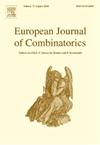Counting deranged matchings
IF 1
3区 数学
Q1 MATHEMATICS
引用次数: 0
Abstract
Let denote the number of perfect matchings of a graph , and let denote the complete -partite graph where each part has size . Johnson, Kayll, and Palmer conjectured that for any perfect matching of , we have for divisible by This conjecture can be viewed as a common generalization of counting the number of derangements on letters, and of counting the number of deranged matchings of . We prove this conjecture. In fact, we prove the stronger result that if is a uniformly random perfect matching of , then the number of edges that has in common with converges to a Poisson distribution with parameter .
计算疯狂的匹配
让 pm(G) 表示图 G 的完全匹配数,让 Kr×2n/r 表示完整的 r 部分图,其中每个部分的大小为 2n/r。约翰逊、凯尔和帕尔默猜想,对于 Kr×2n/r 的任何完全匹配 M,我们有对于除以 rpm(Kr×2n/r-M)pm(Kr×2n/r)∼e-r/(2r-2) 的 2n 的猜想。这个猜想可以看作是计算 n 个字母上的错配数和计算 K2n 的错配数的普通概括。我们证明了这一猜想。事实上,我们证明了一个更强的结果:如果 R 是 Kr×2n/r 的均匀随机完美匹配,那么 R 与 M 共有的边的数量收敛于参数为 r2r-2 的泊松分布。
本文章由计算机程序翻译,如有差异,请以英文原文为准。
求助全文
约1分钟内获得全文
求助全文
来源期刊
CiteScore
2.10
自引率
10.00%
发文量
124
审稿时长
4-8 weeks
期刊介绍:
The European Journal of Combinatorics is a high standard, international, bimonthly journal of pure mathematics, specializing in theories arising from combinatorial problems. The journal is primarily open to papers dealing with mathematical structures within combinatorics and/or establishing direct links between combinatorics and other branches of mathematics and the theories of computing. The journal includes full-length research papers on important topics.

 求助内容:
求助内容: 应助结果提醒方式:
应助结果提醒方式:


